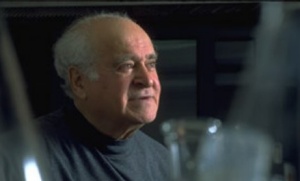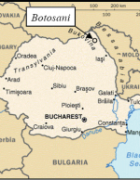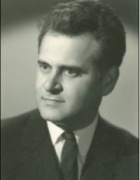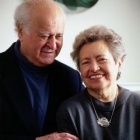Ruckenstein Biography

Over many years, Eli Ruckenstein's prolific and imaginative research had advanced theories in transport phenomena, interfacial phenomena, catalysis, colloidal forces, polymers, surfactants, materials, and countless other diverse areas of chemical engineering and science.
His inspirational story is one of great difficulties but also of great satisfaction. In fact, Eli believed that joy and pain are mixed not only in life but also in scientific research, because you cannot come to the joy of rewarding new research without the painful process of discovering new questions and developing ideas in order to solve them.
The Early Years

Eli Ruckenstein was born in Botosani, a small agricultural town in northern Romania. His family was well off until they lost everything in the Great Depression. This meant that in his formative years he had to struggle and fight poverty.
He began school at seven but at 14 he was expelled due to racial laws. The Jewish community responded by organizing a private high school where the teachers were intellectuals who loved their jobs and, although without the necessary credentials, made schooling interesting and exciting.
In his last two years of high school, he was taken into forced labor six days a week from 5 a.m. to 5 p.m. His task was to carry bricks on a scaffold all day. Although he was out of school, he studied by himself and took exams at the end of each of these two years. At this time he fell in love with mathematics, which he learned by himself, and in this way he laid the educational foundation for the rest of his future studies.
The Start of an Incredible Career
In 1949, Eli secured a position of Assistant Professor at the Polytechnic Institute in the Department of Chemical Engineering, which was quite a miraculous occurrence considering that he was not a member of the Communist Party. Still, because he was not part of the ruling party it took him 15 years to be promoted to associate professor.
Before 1958 Romanian scientists were not allowed to send papers to the West for publication. When this rule was changed, Eli's work reached an international audience, and as a result he became known outside Romania. In 1969 he was invited to spend six weeks in London at the University College and Imperial College.
Escape from the Iron Curtain
When he returned home, there were letters from the University of Minnesota and Clarkson University inviting him to the U.S. The University of Minnesota wanted him to make arrangements through the Romanian Academy of Science. This suggestion was not viable because of the policy of the Romanian government which controlled all institutions, including the Academy, and which was discriminating against persons who were not members of the Communist Party.
Clarkson University had received a grant from the National Science Foundation for a visiting European scientist. This allowed Eli to bypass the Romanian Academy, and consequently he spent one academic year at Clarkson. Subsequently, in 1970, he received a permanent position as Full Professor with tenure at the University of Delaware.
It was not easy for Eli to acclimate to new ways and a new atmosphere, but his American colleagues were very friendly and helpful. Beside the need to accommodate to new ways, he had to deal with an extremely difficult family problem. While his wife was allowed to accompany him to the United States, his two children were not allowed to leave Romania, in order to compel him to come back. In a way. it was like keeping these two minor children (ages 12 and 14) as hostages. It took two years of effort to get the children out from behind the Iron Curtain, and in this process, his colleagues at the University of Delaware, particularly Art Metzner, were of the greatest help. Their son, Andrei, is now a professor of physics at Boston University and their daughter, Lelia, is a literary critic and a writer.
Move to UB

Ruckenstein at 42
In 1971 Professor William Gill, Eli's former chair at Clarkson, moved to UB as Dean of the Engineering School. He encouraged Eli to move to Buffalo as well, and from 1973 to the present he has been a faculty member in our department. In these 35 years, he had educated and influenced many students and he has generated vast amounts of new knowledge. His fame in the profession has led him to become almost a national icon for the department. Indeed when any of us travel to other universities the number of inquiries about him is second only to the question of whether we get a lot of snow in Buffalo! (You can imagine which of these two we never tire of answering.)
Eli was a voracious reader and a true intellectual. He conversed easily on world history, politics, and the history of science and engineering. He had deep knowledge of the course that scientific progress had taken, and he is well versed in the lives and the specific contributions made by many of the great minds that preceded us. He has a bibliographic memory, and is often able to cite his own and others' contributions to a specific area made as long as 50 years ago, specifying both the year and the journal of publication!
At nearly 83 years of age, Eli still worked full time, and finds his work in the department to be extremely satisfying. One source of satisfaction was his interaction with his younger colleagues, who found to be very talented and dedicated and who were doing meaningful research. Eli felt that it is very important to have flexibility in his own work, and he was expanding his research in a variety of new areas. Recently he had acquired interest in areas related to proteins and the thermodynamics of complex systems. Even though he had made his mark with more than 1,000 publications (!), he had no intention in slowing down.
Looking back at his long career and at his long life, he was grateful for the opportunities as well as for the hardships which he encountered, and he considers himself a very lucky man. As he came into his office every morning, he was always excited by the challenge of a new problem to address, by a new theory to explore and by the anticipation of the joy of quest.
Career Accomplishments

Eli and Velina Ruckenstein
Ruckenstein conducted both theoretical and experimental research that not only increased scientists' understanding of the fundamental phenomena of chemical processes but led to the development of enhanced research methods and new materials.
His initial interests were in transport phenomena, and two of his more important contributions were "A generalized penetration theory" and "Scaling and physical models in transport phenomena." In the first, he developed a new similarity transformation on the basis of which numerous unsolved transport equations could be solved, such as mass transfer in wave motion and mass transfer under pulsating flows. In the second, he showed how numerous complex problems could be solved by coupling simple solutions valid in extreme cases. An example is the "Heat transfer under combined forced and free convection." He also suggested a physical model for turbulence near a wall, which he applied to a solid surface and to boiling heat transfer; he developed a theory of thixotropy, theories for foams, a unitary theory of phoretic motions, theories for electrokinetic phenomena involving osmosis and anomalous osmosis, and he extended the simple approach of Prandtl for Newtonian fluids to viscoelastic fluids.
After arriving in the U.S., his research diversified widely, encompassing the areas of catalysis, colloids, phase transformations, thermodynamics, and materials. In catalysis, he pioneered the areas of stability of supported metal catalysts and catalytic combustion, and he suggested solid solution catalysts for CO₂ reforming of CH₄. He also developed a theory for the mechanism of oxidation by mixed oxides, proposed kinetics for the selectivity of the catalytic processes, and was the first to use quantum mechanics in the interpretation of catalytic reactions.
In the area of colloids and interfaces, he introduced the concept of interaction force boundary layer in the examination of the deposition of particles on surfaces, he performed simulations to understand the collective behavior of a large number of charged colloidal particles, and he developed a theory for hydration forces, theories for specific ion effects, for steric repulsion, and for bridging forces. He showed that hydration and double-layer forces should be coupled in a unitary treatment and he changed the traditional treatment of double layers. He developed a thermodynamics of surfactant aggregation and a new kind of thermodynamics for microemulsions, lamellar liquid crystals, and phospholipids monolayers. He was concerned with the phospholipid bilayer and examined the interactions between them. He developed theories for wetting and for the stability of both Newtonian and non-Newtonian thin films.
In the area of molecular thermodynamics, he developed theories for the solubility of gases and pharmaceutics in binary and multi-component solvents and for the solubility of proteins. He also developed theories for salting in and out and for the local composition in liquid mixtures.
In the area of kinetics of phase transformation, he developed theories for nucleation for unary and binary mixtures, free of macroscopic thermodynamic concepts, based on a first passage time. He also developed unitary theories for nucleation and growth.
In the areas of polymers and materials, he suggested and implemented numerous technological approaches to prepare composites, conductive polymers, membranes for separation processes, polymers with unusual properties, pastes with high thermal conductivity, and more recently, materials for H₂ storage.
In addition to his election to the National Academy of Arts and Sciences in 2012, receiving the National Academy of Engineering Founders Award in 2004, and the 1998 National Medal of Science, Ruckenstein was honored by the American Institute of Chemical Engineers with its most prestigious awards: the Founders Award in 2002 for outstanding contributions to the field of chemical engineering, the Alpha Chi Sigma Award in 1977 for excellence in chemical engineering research, and the Walker Award for excellence in contributions to chemical-engineering literature in 1988. He received the 1986 Kendall Award of the American Chemical Society for creative theories and experiments in colloid and surface science and, in 1994, the society's Langmuir Lecture Award. In 1996, he was awarded the American Chemical Society's E.V. Murphree Award in Industrial and Engineering Chemistry. He received the Senior Humboldt Award of the Alexander von Humboldt Foundation in West Germany in 1985 for his work related to detergents, and the Creativity Award from the National Science Foundation for his work on protein separation. The Hauptman-Woodward Medical Research Institute honored him in 2003 with inclusion in their Pioneers of Science Award. In 1990, he became a member of the National Academy of Engineering.